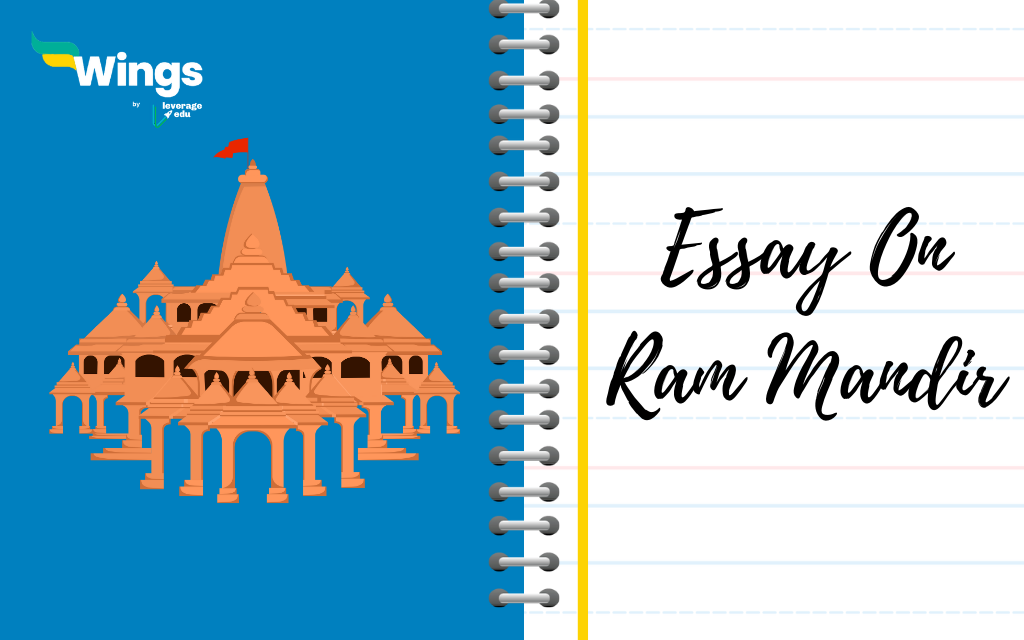Essay on Ayodhya Ram Mandir in English: The day of Lord Rama’s idol consecration ceremony at Ayodhya Ram Mandir was one of the most significant days in Indian history. On 22nd January 2024, the ‘Pran Prathistha’ ceremony at Ayodhya Ram Mandir took place. Prime Minister Narendra Modi, UP CM Yogi Adityanath and other VVIPs of the country were present at the ceremony.
As a way to improve communication skills, students are encouraged to write essays and paragraphs about a variety of national and international topics. A lot of students are given assignments to describe in their own words the amazing beauty of the magnificent Ram Mandir, since this day has been carved with golden words in Indian history, giving it particular significance. Check out this essay on Ayodhya Ram Mandir in English, which schoolchildren can use as an example to explain the chronology, history, and glory of the spectacular Temple.
Contents
Explore 200+ Essay Topics for School Students in English
Essay on Ayodhya Ram Mandir in 100 Words
The majestic temple known as the Ayodhya Ram Mandir is situated in the holy city of Ayodhya. This city is situated on the bank of the Saryu River and is located in the northern region of India. Built at the birthplace of Hinduism’s foremost deity, Rama, it is called Ram Janmbhoomi. There have been long-standing disagreements and debates around the Ayodhya Ram Mandir, that involve both political and religious dimensions. Recently inaugurated, the Ayodhya Ram Mandir is thought to be the precise location of Lord Rama’s birth. It has been said that his ancestors made a temple there to honour his life and birth. In the medieval period, Mughal Emperor Babur destroyed the Ram Temple and built the Babri Masjid, to promote Islam in India. The climax of this incident took place in 1992, when a group of Hindu devotees demolished the Babri Masjid, claiming it to be the birthplace of Lord Ram. After 32 years, the Ram Temple inauguration took place under the authority of Prime Minister Narendra Modi.
Learn the Basics: How to Write an Essay in English: Format, Samples, and Tips
Essay on Ayodhya Ram Mandir in English in 250 Words
The sacred city of Ayodhya is home to the magnificent temple known as the Ayodhya Ram Mandir. Situated in the northern part of India, the city is on the banks of the Saryu River. Constructed at the birthplace of the most revered deity in Hinduism, Rama, it is known as Ram Janmbhoomi.
It is thought that Rama was born precisely at the location where Ram Mandir was constructed by his ancestors to honour his life and birth. However, around the sixteenth century, the Mughal ruler Babur demolished the temple and built the Babri Masjid, a mosque. Later, in 1992, a group of Hindu militants destroyed the mosque, setting off violent riots and other religious unrest throughout the nation. For years, there has been debate and litigation around the ownership and status of the property.
Ayodhya Ram Mandir’s history is complicated, connected with arguments and obstacles. The completion of Ram Mandir represents the end of a long-running dispute. The Ram Mandir’s artistically carved sandstone, which includes domes, pillars, and engravings whispering tales of Rama’s journey, is a reflection of traditional Hindu architecture. The temple is more than merely a monument; it represents tenacity, optimism, and a path toward peace. Because of this, the Ayodhya Ram Mandir is far more than an ordinary building; it’s an important representation of spiritual principles, cultural history, and firm faith.
Also Read: Essay on Rajendra Prasad in 100, 200 and 500 Words
Essay on Ayodhya Ram Mandir in English in 500 Words
The Ayodhya Ram Mandir, located in the city of Ayodhya in Uttar Pradesh, India, is one of the most prominent religious sites in the country. It stands as a symbol of faith, perseverance, and the rich cultural heritage of India. The temple is dedicated to Lord Ram, one of the most revered deities in Hinduism, who is believed to be the seventh incarnation of Lord Vishnu.
Historical Background
The history of the Ayodhya Ram Mandir is both fascinating and complex. According to ancient Hindu texts, Ayodhya is the birthplace of Lord Ram, making it a significant place of worship for Hindus. The site where the temple is being constructed is believed to be the location of Lord Ram’s birthplace, known as Ram Janmabhoomi.
In the 16th century, a mosque called the Babri Masjid was built on this site by Mughal emperor Babur. For centuries, the site was a point of contention between Hindus and Muslims, leading to disputes and conflicts over its ownership. The matter came into the national spotlight in 1992 when the Babri Masjid was demolished, leading to widespread communal violence.
Legal Battle and Verdict
The dispute over the Ram Janmabhoomi-Babri Masjid site led to a prolonged legal battle. After decades of hearings and deliberations, the Supreme Court of India delivered its landmark judgment on November 9, 2019. The court ruled in favor of constructing the Ram Mandir at the disputed site and allotted an alternative five-acre plot in Ayodhya for the construction of a mosque.
Construction of the Ram Mandir
The foundation stone for the Ram Mandir was laid on August 5, 2020, by Prime Minister Narendra Modi. The temple’s design is inspired by ancient Indian temple architecture, with intricate carvings and grand structures. The temple is being built using pink sandstone from Rajasthan and is designed to last for over a thousand years.
The Ram Mandir will feature a sanctum housing the idol of Lord Ram, surrounded by beautifully carved pillars, domes, and an expansive courtyard. The project is expected to be completed by 2025, drawing devotees and tourists from all over the world.
Significance of the Ram Mandir
The Ayodhya Ram Mandir holds immense religious and cultural significance. For millions of Hindus, it represents the fulfillment of a long-cherished dream. The temple is not just a place of worship but also a symbol of India’s spiritual and cultural heritage. It highlights the values of dharma (righteousness), devotion, and unity.
The construction of the temple has also contributed to the economic development of Ayodhya. The city is witnessing increased infrastructure development, including better roads, hotels, and facilities for pilgrims and tourists. The Ram Mandir is expected to boost religious tourism, providing livelihood opportunities for many locals.
Conclusion
The Ayodhya Ram Mandir stands as a testament to faith, determination, and the peaceful resolution of long-standing disputes. It is a symbol of India’s rich history and spiritual ethos. As the temple nears completion, it inspires hope for unity and harmony among diverse communities. The Ayodhya Ram Mandir will undoubtedly remain a cherished landmark for generations to come, reminding us of the enduring power of faith and the importance of preserving cultural heritage.
5 Interesting Facts About Ayodhya Ram Mandir
- With more than fifteen generations of temple architecture experience, the Sompura family created the design for the Ayodhya Ram Mandir.
- The Ram Mandir is constructed entirely of stones, copper, white cement, and wood. Neither iron nor steel is used in its construction.
- The Ram Mandir, which occupies 70 acres, 70% of which is green space, is the largest temple in India.
- A 2000-foot-deep time capsule at the temple holds information on the origins of Lord Rama and the history of Ayodhya.
- The temple features a constellation-based garden with 27 different plant species, each of which represents one of the 27 nakshatras (star constellations).
Also Read: Essay on Pongal in 100 to 400 Words in English
Timeline of Major Events
| Date | Event | Importance |
| 30 September 2010 | Allahabad High Court Verdict on Controversial Land | Hindu and Muslim parties share contested territory after a court ruling. |
| 9 November 2019 | Supreme Court verdict | Hindu groups obtain disputed property from the court, opening the door for the construction of Ram Mandir. |
| February 2020 | Formation of Ayodhya Ram Mandir Trust | A trust was set up to oversee the development of the Ram Mandir. |
| 5 August 2020 | Bhumi Pujan ceremony | Ceremonial opening that started the construction of Ram Mandir |
| 22 January 2024 | Inauguration of Ram Mandir | The official and grand inauguration of the Ayodhya Ram Mandir |
FAQs
Ans: The temple is being constructed on a controversial area of land in the city of Ayodhya, which is regarded by many Hindus to be the birthplace of Ram.
Ans: The Mughal emperor Babur’s commander Mir Baqi built the Babri Masjid in 1528, which marked the start of the Ram Temple movement. Decades of disagreements and hostilities between the two populations were caused by the notion that the mosque was constructed on the site and the ruins of a Hindu temple.
Ans: It is situated in the location of Ram Janmabhoomi, the birthplace of Hinduism’s foremost deity, Rama. Built in the sixteenth century CE, the mosque was built on the site of the remnants of a Hindu temple leading to decades of disputes and hostility between the Hindu-Muslim populations.
Ans: The temple was inaugurated on January 22, 2024, following a consecration ceremony. Built in the traditional Nagara style of Indian temple architecture, the temple measures 380 feet in length, 250 feet in width, and 161 feet in height. It comprises three floors, each 20 feet high, and includes five mandaps (halls): Nritya Mandap, Rang Mandap, Sabha Mandap, Prarthna Mandap, and Kirtan Mandap. The temple is constructed primarily from pink sandstone, reflecting intricate craftsmanship and a blend of traditional and modern architectural techniques.
Ans: The site has been a focal point of religious significance and dispute. In the early 16th century, the Babri Masjid mosque was constructed at this location. In 1992, the mosque was demolished, leading to communal tensions. After extensive legal proceedings, the Supreme Court of India, in 2019, awarded the disputed land to Hindu parties for the construction of the Ram Mandir and allocated an alternative plot for the construction of a mosque, aiming to maintain religious harmony.
Related Articles
This was all about an Essay on Ayodhya Ram Mandir in English for Students. For more information on such interesting topics, visit our essay writing page and follow Leverage Edu.
 One app for all your study abroad needs
One app for all your study abroad needs














